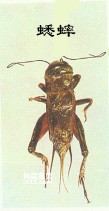[Economic significance] Orthoptera includes our common locusts, grasshoppers, katydids, crickets, mole crickets, fleas, etc. Except for a few predatory species, the vast majority are herbivorous, and many of them are important pests in agriculture, forestry, and horticulture. The most famous ones are locust plagues. Most of them can pronounce sounds, and some have pleasant sounds and are famous song insects; some are aggressive by nature and are fascinating play insects; and some have bizarre shapes or mimicry, which is pleasing to the eye. Therefore, they are important insects for ornamental and entertainment resources.
[Identification characteristics] Body length 2.5-90 mm. The mouthparts are chewing, the front chest and back are large, and the hind feet are jumping. Wings vary in length and sometimes are wingless. The forewings are covered wings, leathery, with submarginal veins. Females have well-developed ovipositors. The tail whiskers are short and the segmentation is not obvious. Often have well-developed articulators and hearing instruments. Gradual metamorphosis.
[Species and Distribution] There are more than 20,000 known species in the world, which are widely distributed around the world. There are more species in tropical and temperate regions, but there are fewer species and fewer individuals in high latitudes and high altitudes. They are more terrestrial, less burrowing, and even fewer live near water.
The characteristics of this order can be summarized as follows: the hind legs are good at jumping orthoptera, the chest is well-developed and the forewings are covered; the male sings and the female has an ovipositor, which is similar to locusts, katydids and crickets.
[Classification system and introduction to common families]: Orthoptera is usually divided into 2-3 suborders. The three sub-categories are now introduced as follows.
① The tentacles of the suborder Tettigoniodea are filamentous and have more than 30 segments. The length of the antennae is greater than or equal to the length of the body. The hearing organ is located at the base of the tibia of the forefoot. The ovipositor is long.
A. Tettigoniidae
The tarsal segments are 4-4-4 (the tarsal segments of all three pairs of feet are 4 segments). The ovipositor is sword-shaped or sickle-shaped, and the tail is short and hard.

B. Gryllidae
Tarsi 3-3-3. The ovipositor is needle-shaped or spear-shaped, and the tail is long and soft.
②Acridodea (Locustodea)
The antennae are shorter than the body, less than 30 segments, and are generally filamentous. The hearing organs are located on both sides of the first abdominal segment. The ovipositor is short and valve-shaped.

A. Acridiidae (Locustidae)
The pronotum does not extend posteriorly. The antennae are longer than the length of the foreleg segments. Tarsi 3-3-3.
B. Grasshopper family Tetrigidae
The body is small and rhombus-shaped, so it is also called rhombus locust. The pronotum extends posteriorly, covering the entire abdomen. The forewings are small and scale-like. No hearing aids. Tarsi 2-2-3.

C. Eumastacidae (Eumastacidae)
The antennae are shorter than the foreleg segments, and there is a small protrusion at the proximal end of the antennae. No hearing aids.
③Gryllotalpode
There is no hearing device, the front feet are digging, and the ovipositor is not exposed.
Gryllotalpidae
The antennae have more than 30 segments and are filamentous. The tail whiskers are unsegmented and long.
animal tags:
We created this article in conjunction with AI technology, then made sure it was fact-checked and edited by a Animals Top editor.